Do you want to know about the history of WordPress?
If you are starting a WordPress blog or website today, then you may know that WordPress is a popular website builder which powers more than 43% of all websites on the internet. But it didn’t start out that way.
In this article, we want to take a look back at the history of WordPress to show you how it evolved over time.
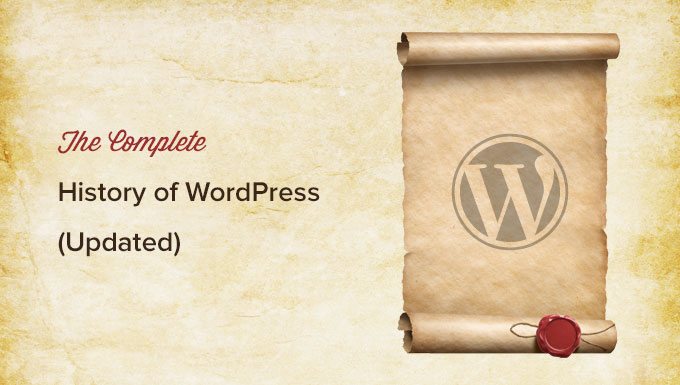
The story of WordPress tells us how open source communities work to make something so useful without compromising software freedom. The WordPress project is driven by a community of dedicated developers, users, and supporters. That’s why WordPress is free.
WordPress started out because the development of an existing blogging software b2/cafelog was discontinued by their main developers. In 2003, two users of b2/cafelog, Matt Mullenweg and Mike Little, decided to build a new platform on top of b2/cafelog.
They probably didn’t know that they were about to start a journey that would eventually benefit millions of users around the globe, and that a whole industry of thousands of developers, designers, writers, bloggers, and web publishers would make their living off it. Today, WordPress powers over 43% of all websites on the internet.
Let’s take a look at the history of WordPress.
On May 27, 2003, Matt announced the availability of the first version of WordPress. It was well-received by the community. It was based on b2 Cafelog with significant improvements. The first version of WordPress included a new admin interface, new templates, and generated XHTML 1.1 compliant templates. The post editor looked like this:
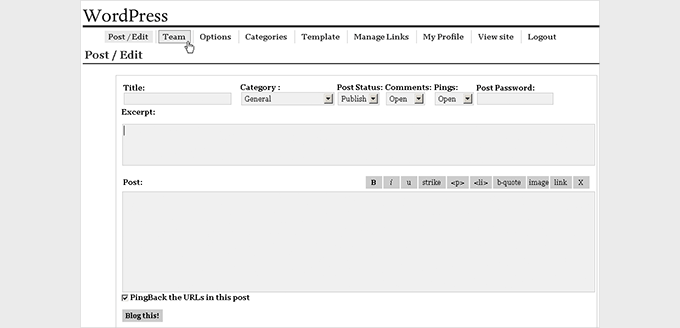
In May 2004, version 1.2 of WordPress came with the plugin architecture. This enabled users and developers to extend the functionality of WordPress by writing their own plugins and sharing them with the rest of the community.
As WordPress was opening itself to the community, something totally opposite was happening in the blogging industry at that time.
The market leader in the blogging tools industry at that time was Moveable Type. They announced new licensing terms which were not liked by many of their users. This forced many of their users to look for a new blogging platform.
In contrast, WordPress 1.2 presented itself as an ambitious project offering users a mature, stable, easy, and flexible platform with features that rivaled their proprietary competitors. The adaption rate of WordPress skyrocketed with this release.
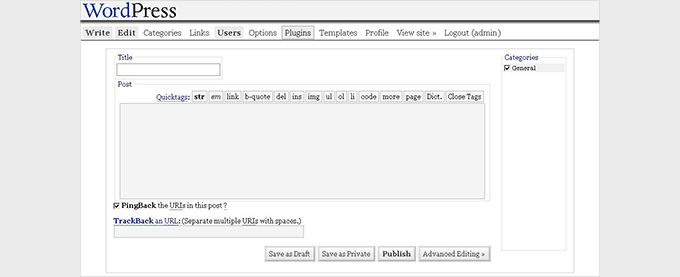
With the increase in the number of users, WordPress started getting better with the help and interest of the community.
In February 2005, WordPress 1.5 came with Pages, comment moderation tools, new default theme Kubrick, and a completely new Theme System. Matt announced themes with these words:
In 1.5 we have created an incredibly flexible theme system that adapts to you rather than expecting you adapt to it. You can have your entire weblog run through a single file, just like before, or you can literally have a different template for every single different category. It’s as much or as little as you want. We’ve also broken common site elements like headers, footers, and sidebars into their own files so you can make a change in one place and see it everywhere immediately.
“Matt Mullenweg – Announcing WordPress 1.5“
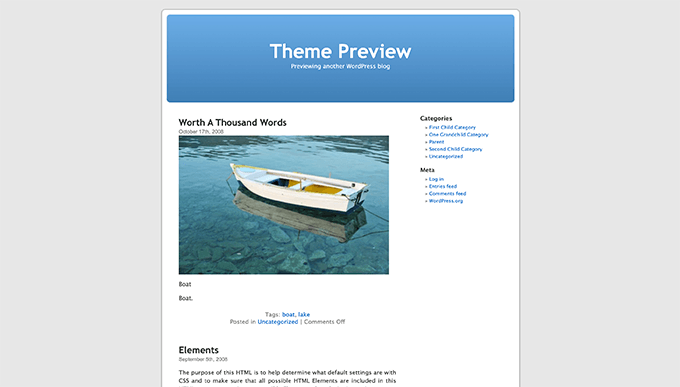
In December 2005, WordPress 2.0 was released with a new admin dashboard. This new admin area was a complete overhaul of the administration screens in WordPress.
It used JavaScript and DHTML to make a better user interface where users did not need to load a page to perform some simple tasks. Users were now able to add categories and tags to posts without leaving the post editor or delete comments without reloading the comments screen.

The shiny new admin UI was not the only significant improvement in this release.
It was the first release that came with Akismet anti-spam plugin pre-installed. It also came with a WordPress database backup plugin, wp-db-backup, which was then dropped in 2007. Another first for this release was the introduction of a functions.php file in the Theme System.
On March 1, 2006, Automattic, the company founded by WordPress co-founder Matt Mullenweg, filed the trademark registration for WordPress and WordPress logo.
In 2008, a web design company called Happy Cog joined the WordPress project to help design a new WordPress admin interface. A usability study was conducted to design the admin UI.
Throughout the year new features such as shortcodes, one-click updates, and built-in plugin installation were added to WordPress with different releases.
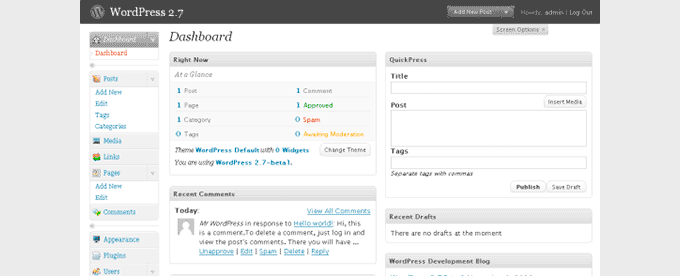
In July 2009, WPBeginner was launched by 18-year-old web developer Syed Balkhi. He decided that instead of maintaining his clients’ WordPress websites, he would teach them to do it themselves.
WPBeginner quickly became the largest unofficial WordPress resource site for beginners, and it led to the birth of Awesome Motive, the leading WordPress product maker whose plugins are used by over 25 million websites.
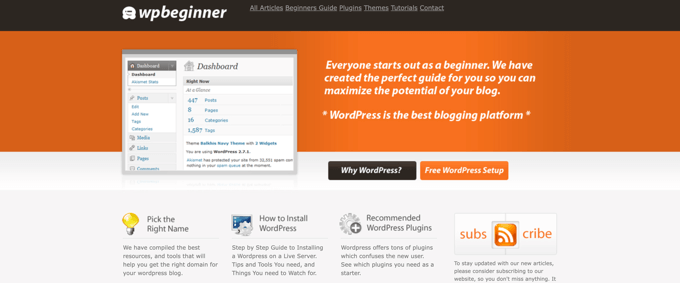
In June of 2010, Automattic, the company founded by WordPress co-founder Matt Mullenweg, transferred the ownership of WordPress trademark and logo to the WordPress Foundation. This was a significant moment in WordPress history, because it ensured that WordPress will continue to grow, and is not dependent on a company or a group of developers to continue the project.
On June 17, 2010, WordPress 3.0 was released. It was a major step towards WordPress as CMS. This release introduced several features such as custom post types, better custom taxonomies, custom backgrounds, header, menus, contextual help on admin screens, etc. WordPress MU project was merged into WordPress core to create Multisite networks.
It also came with the Twenty Ten theme, which started the tradition of a new default theme for each year.
In 2011, Post formats and admin bar made their way into WordPress.
Around that time, some really cool WordPress plugins were building powerful eCommerce platforms on top of WordPress. This enabled WordPress users to create online stores and build powerful ecommerce websites using WordPress.
In 2012, theme customizer, theme previews, and new media manager were introduced. These features tremendously helped new users in creating image galleries and previewing themes before they change to a new theme.
In 2013, WordPress 3.7 came with the new automatic updates feature that allowed WordPress to automatically update your site’s software for minor releases. The automatic updates feature is very similar to what Google Chrome browser does. Several users didn’t like the feature, so we wrote a tutorial on how to disable automatic updates.
By this time WordPress had already became the most popular CMS in the world.
In December 2013, WordPress 3.8 was released which introduced MP6, the new WordPress admin interface. This new interface was responsive and was aimed at providing a better user experience to users, on any device or screen size.
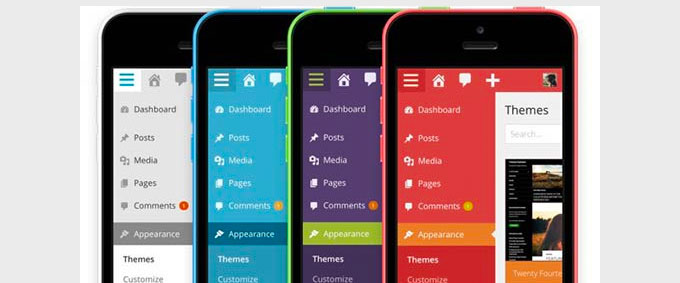
On April 16, 2014, WordPress 3.9 was released. It focused on improving the WordPress visual post editor. Images can now be dragged and dropped directly into the post editor. Users are now able to edit images right inside the editor and see their gallery previews inside the editor. WordPress 3.9 also introduced live widget previews, audio playlists, and several other enhancements.
More refinements were made to WordPress core throughout the year with subsequent WordPress 4.0 and WordPress 4.1 releases.
2014 was also the first year when non-English downloads for WordPress surpassed English downloads.
In 2015, WordPress 4.2, 4.3, and 4.4 were released. These releases focused on improved localization, emoji support, theme customizer, and laying down infrastructure for the WordPress REST API.
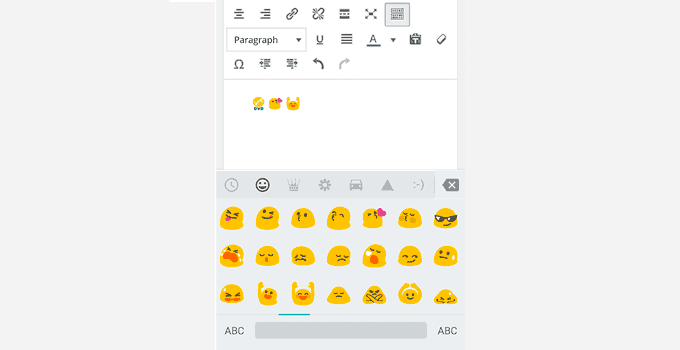
In the same year, WooCommerce, the most popular WordPress eCommerce plugin was acquired by Automattic (the company founded by WordPress co-founder Matt Mullenweg).
In 2016, WordPress 4.5, 4.6, and 4.7 were released. Each release introduced some new features and improvements. The most notable changes during the year were streamlined updates for plugins and themes, content recovery by using browser storage, and custom css feature for theme customizer. By the end of the year, WordPress.org announced actively supporting HTTPs.
In 2017, WordPress 4.8 and 4.9 were released. These releases brought several new default widgets to add audio, video, images, gallery, rich text, and HTML. These releases also laid the groundwork for the new WordPress block editor.
In 2018, WordPress 5.0 was released with a brand new editing experience. The new WordPress block editor project was codenamed Gutenberg. See our complete Gutenberg tutorial – WordPress block editor.
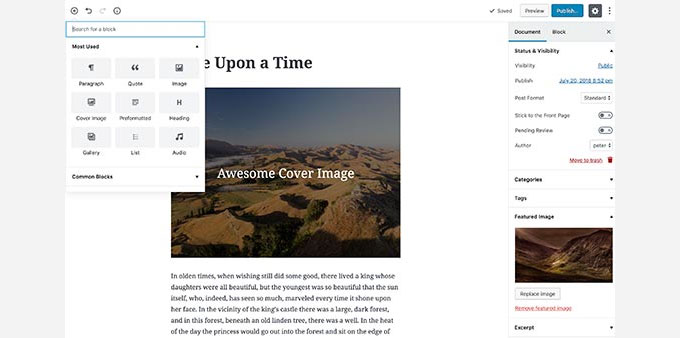
The block editor remained the focus of WordPress development as the community moved towards widespread adaptation.
In 2019, WordPress started implementing the Site Health project into the core. With WordPress 5.1 and 5.2, Site Health started showing users notifications when an older PHP version is detected.
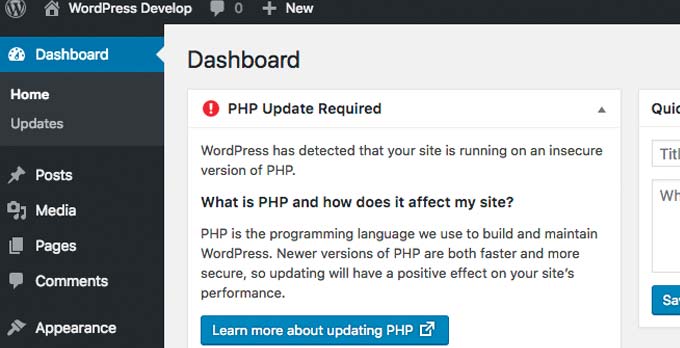
It also added protection for White Screen of Death by allowing users to log in securely in case of a critical error and then fix it from within the WordPress dashboard.
In 2020, the WordPress community faced unexpected challenges due to the break out of a global pandemic. WordCamp events around the globe were canceled and the community organized meetups virtually.
Luckily, a large number of WordPress community members and developers were familiar and used to the remote work. The development continued and three major WordPress releases (5.4, 5.5, and 5.6 ) came out.
Among many improvements, work began on the Full Site Editing experience, automatic updates were added, and block directory, block patterns, and lazy loading images were introduced.
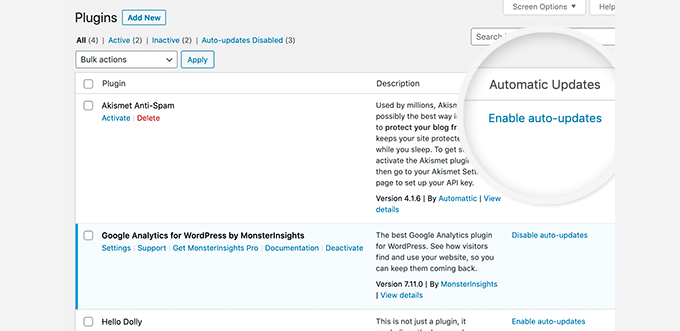
In 2021, work took off on full site editing features with WordPress 5.7 and 5.8. A new templates feature was introduced along with several site-wide blocks to easily create site-wide templates in WordPress.
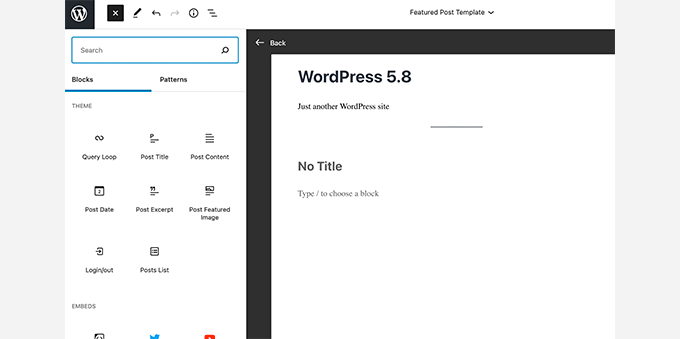
Over the last few years, WordPress has continued to improve the block editor in an effort to offer a full site editing solution.
A lot of progress has been made in this area, but for now, we still recommend readers use a drag & drop WordPress page builder instead for more design control.
In 2022, WordPress remained focused on improving the full site editing experience. More site editing blocks were added in WordPress 5.9, and many WordPress themes started offering a better site editing experience based on the block editor. See our list of full site editing themes.
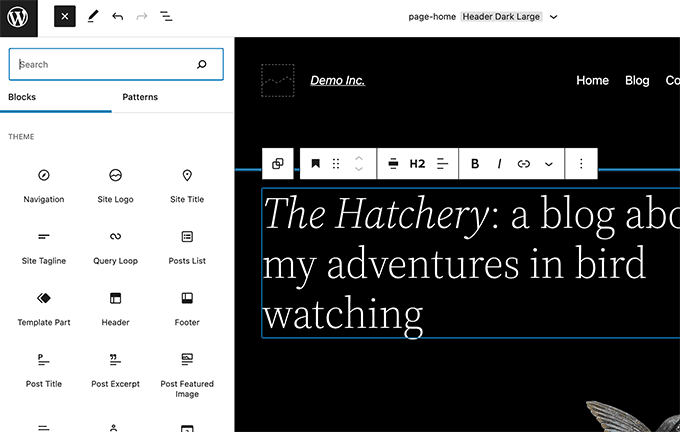
In 2023, WordPress 6.2 was released where the WordPress full site editing came out of beta. A new template browsing experience was added to make it easy for anyone to create custom WordPress layouts using the site editor (no coding needed).
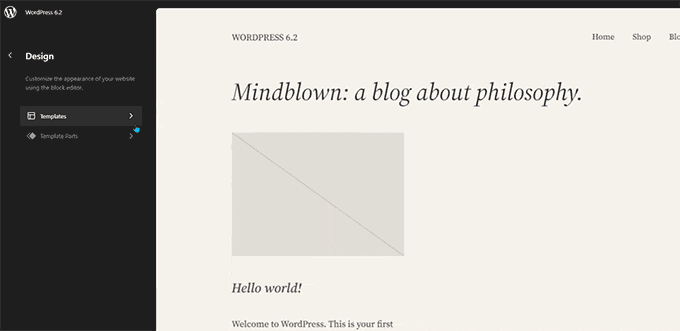
Aside from that WordPress also re-introduced the distraction free writing.
This is a popular content creation mode in the block editor (a.k.a Gutenberg).
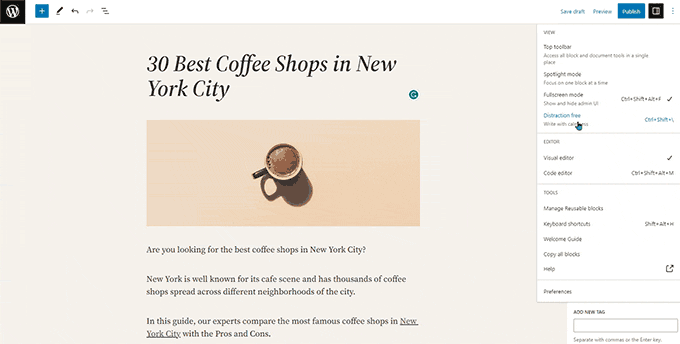
In late 2023, WordPress 6.4 was released.
With it, launched the next default theme, Twenty Twenty-Four, with a focus on patterns and further enhancing full-site editing capabilities.
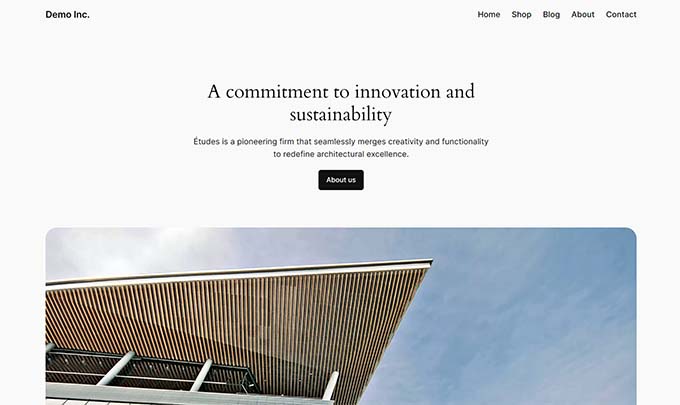
What’s Next for WordPress?
WordPress is continuously evolving to address the needs of the millions of web publishers around the world. The direction of WordPress directly depends on the needs of users. We can safely assume that it will continue to empower people around the world to create wonderful web spaces.
We hope this article helped you understand the history of WordPress. You may also want to see how WordPress works behind the scenes (infographic) and what are the best WordPress plugins that every website should use.
If you liked this article, then please subscribe to our YouTube Channel for WordPress video tutorials. You can also find us on Twitter and Facebook.





Syed Balkhi says
Hey WPBeginner readers,
Did you know you can win exciting prizes by commenting on WPBeginner?
Every month, our top blog commenters will win HUGE rewards, including premium WordPress plugin licenses and cash prizes.
You can get more details about the contest from here.
Start sharing your thoughts below to stand a chance to win!
Jiří Vaněk says
A beautiful look into the history of WordPress. I started working with it in 2006 when I joined a company that provided web hosting solutions. My first experience was with WordPress version 2, and it’s been many years since then. Three years later, I started my first blog. This article is a lovely nostalgia trip for me, reflecting on how WordPress has evolved. You’ve crafted the article very well, and I thoroughly enjoyed reminiscing about my beginnings with WordPress thanks to this article.
Moinuddin Waheed says
I think the best decision in the history of these 20 years of wordpress was the decision taken by wordpress co founder Matt Mullenweg for transferring of WordPress trademark and logo to the WordPress foundation.
it was this decision which ensured wordpress to continue as an open source and is being contributed by the largest wordpress developers community.
Thanks for bringing this awesome history of WordPress.
Jen Libby says
Thanks so much for the info, great read! Your article says that WP 4.6 was released in 2016, which is true, yet the list of WP versions on wordpress.org shows that 4.6.18 was just released on April 29, 2020. How can this be, especially since we are currently at 5.4.1? Any idea?
WPBeginner Support says
That is a security update for those users who have not updated their sites to a newer version so they’re not vulnerable to any found security issues.
Admin
Bill Tarn says
Wpbeginner u always made my day when ever I read your article you guys are great. U love you so much.
WPBeginner Support says
Thank you, glad you like our articles
Admin
Jasica James says
Very well written article. No doubt your research is very vast covering the entire history of WordPress. Keep it up and keep posting such wonderful stuff.
WPBeginner Support says
Thank you, we’ll certainly keep putting out more articles
Admin
Clarence Johnson says
Thank you for producing and sharing this. User since 2008.
John Mauldin says
I met Matt Mullenweg at one of the very first Wordcamps held in Frisco, Texas, an up and coming new Dallas city. The setting was almost lavish, high back, heavily upholstered leather chairs in a semi-circular auditorium that was where the political leaders of Frisco assembled.
Matt as a very soft-spoken man who came across unassuming, approachable and…… contagious due to his passion for wordpress and his vision of the future. With plenty of other attendees and a room full waiting, he took the time to paint a picture of wordpress and what it would mean to me to take my over 150 sites to a new level through wordpress. I was very impressed then and even more impressed of the growth and development exhibited by this man and a first class team of net specialists.
Scott Smith says
Quite interesting, but would be even more so had it included the number of WP users and/or sites over the years.
Er.Shivam Kumar says
Inspiring i hope same thing happens to a strong framework named codeigniter which is seeking a new owner
Kate_H says
Great post. As a avid WP user and web designer I’ve often wondered about the history of WP but never seem to have the time to delve into it. This had made me even more determined to set aside some time to read and discover more about WP’s origins, so thank you.
Davide De Maestri says
Nice post! I didn’t know first WordPress years, thanks for sharing!
Robby McCullough says
Beautiful post! I recently found out that all of WordPress’ version history is available to download and toy around with. I wanted to go back, install a few versions, and see how the software has evolved over the years. This just saved me a bunch of time!